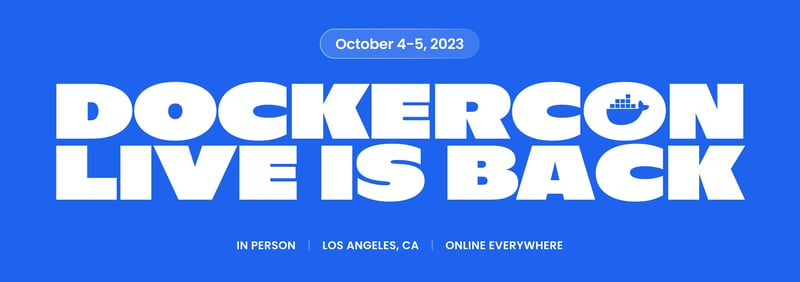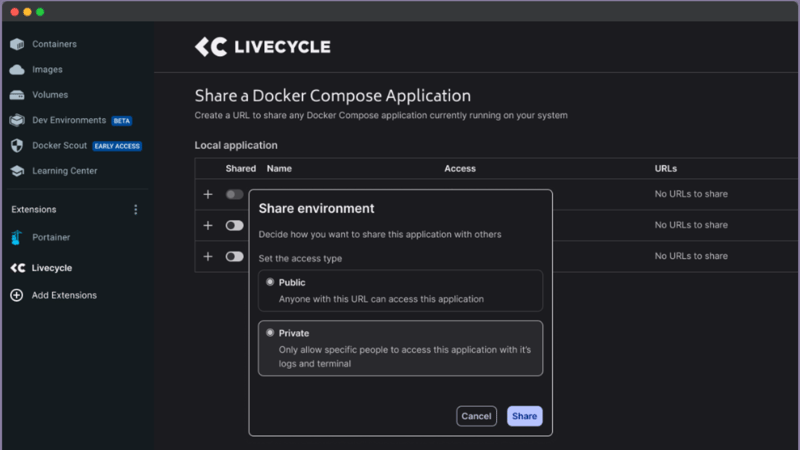TL;DR
This post is part our ongoing series of Docker insights, announcements and launches in celebration of DockerCon 2023 and in appreciation for everything that Docker has done for the developer community at large.
Docker's Recent Product Announcements
Docker has already made a few announcements at this week’s DockerCon 2023. Most notably, the launch of 3 new products that harness the power of local and cloud development environments, allowing developers to quickly, and securely build, share, and run any app, anywhere.
And while this is newsworthy by any measure - it’s easy to overlook just how big of a deal this is for developers everywhere.
First let’s appreciate the 3 new products that were announced during the conferences keynote address:
- Docker Scout - Today, the tools, processes, and people involved in the software supply chain require too much context switching for developers. Feedback is often late and unclear, leaving developers to wonder how they can improve software quality. Complementing Docker’s existing trusted content, build automation and SBOM tools, Docker Scout adds relevant insights, policy evaluation, and contextual remediation, all while meeting developers where they are via integrations with Sysdig, JFrog Artifactory, AWS ECR, BastionZero, GitHub, GitLab, CircleCI, and Jenkins.
- Docker Build - Dev teams can waste as much as an hour per day per team member (!) waiting for their image builds to finish. To address this, next-generation Docker Build speeds up builds by as much as 39 times (!) by automatically taking advantage of large, on-demand cloud-based servers and team-wide build caching.
- Docker Debug - Developers spend as much as 60% of their time debugging their applications. But much of that time is spent sorting and configuring tools and set-up instead of actual debugging. Docker Debug provides a language-independent, integrated toolbox for debugging local and remote containerized apps, enabling developers to find and solve problems faster.
Improving the “here and now” developer experience
With these products, Docker is clearly making “shift-left” the new standard in developer experience. Each of these new tools aims to achieve a singular goal for developers everywhere: combine the responsiveness and convenience of local development with the on-demand resources, connectedness, and collaboration possibilities of the cloud. This combination enables developers to do their best work much earlier in the SDLC than they ever imagined possible.
Not surprisingly, Docker CEO Scott Johnston said it best: “The cloud offers many potential benefits for development teams, but most ‘inner-loop’ solutions require a complete change in tools and workflows — and very few developers want to ship their entire laptop to the cloud. The new products we announced today meet development teams where they are with ‘just enough cloud,’ seamlessly blurring the boundaries between local and remote development. In doing so, we’re enabling these teams to accelerate their delivery of secure applications critical to their businesses.”
Frederic Lardinois from TechCrunch further quoted Johnston that in the early days of the container revolution, apps typically didn’t consist of more than a handful of containers. Now, those apps are often made up of 20 or 30 containers and that puts a lot of pressure on your typical developer laptop. “Moreover, when they’re working on an app locally, it’s hard to share a running app with your colleagues,” Johnston added. “And if that app you’re working on locally is dependent on some remote service, like a database as a service in the cloud or an AI service, it’s kind of hard, especially with security and such up your grill if you’re working in a large environment.”
Some companies have tried to get around this by moving the entire development process into the cloud by offering developers cloud-based IDEs, for example. But Johnston argues that this isn’t something that every company is going to be comfortable with. He also said that what Docker is hearing from its customers is that this breaks existing workflows. “Because of where we are on the local laptop, where Docker Desktop sits, we see a unique opportunity to not make it either/or — not local or cloud — but local and cloud and bring the best of both worlds together.”
Put simply, Docker’s new tools are built to combine the power of local and cloud to make the ‘here and now’ developer experience as effective and efficient as possible.
But Wait… There’s More…
Perhaps the most amazing thing about Docker’s announcement is the part that they didn’t say explicitly.
Docker users around the world are quickly realizing that these products were not launched in a vacuum. They represent an extension to the existing suite of Docker products, such as Docker Desktop, Private Repos, and Docker Hub - a marketplace for discovering and distributing trusted dev-centric content and tools.
Docker is launching these new products as the newest additions to their already robust platform. And this platform, in turn, enables other developers and devtools companies throughout the ecosystem to join Dockers Shift-Left call to action and extend these capabilities even further with complementary tools and contributions of their own.
Livecycle + Docker = Extended Dev Collaboration
A perfect example of Docker’s platform in action is what’s currently happening here at Livecycle. Like Docker, our mission is to enable developer collaboration by bringing other stakeholders into the developers’ immediate context in an effective an unintrusive way.
We have built tools that allow developers to share their work at any point in the workflow and get clear, actionable feedback in context so it can be addressed easily.
Historically, many developers have preferred to facilitate this type of collaboration with ephemeral preview environments that are triggered with every PR or commit. And indeed, we have built robust solutions like “Preevy” to facilitate the creation of these environments for dockerized applications on any cloud or Kubernetes cluster.
The magic of these environments is not just in the creation and sharing of the preview itself, but also in our built-in collaboration tools that enable all stakeholders to join the review process immediately and leave feedback in a shared context that is dev-centric and dev-friendly.
And now, in line with Docker’s strategic vision, we’ve extended this capability left-wards with the launch of our new Docker Extension.
We’ve leveraged the power of the Docker Extensions Marketplace to build a tool that enables developers to instantly share local containers with anyone, without the need for staging environments or CI builds.
And our built-in collaboration tools enable technical teammates access for remote debugging and less technical teammates the ability to leave review feedback in context, while the code is still sitting on the developer’s machine.
These local ENVs can also be provisioned to the cloud as self-hosted preview environments, giving developers the local + cloud flexibility and accessibility they have been so clearly asking for.
‘Docker Collaborate’ with Livecycle
You could argue that Livecycle’s collaboration layer can also be called “Docker Collaborate” - a fourth contribution to the wider Docker community that is rolling out this week.
Docker’s three native products focus on empowering the developers themselves, and Livecycle’s tools extend this to also empower the rest of the team to create a truly collaborative development experience.
Focusing on both the developer's developer experience and the ability to include other stakeholders early in the process is the two-way street that is needed to deliver optimal development efficiency and productivity.
In-Flight UI Reviews
One of the most common use cases for the new Livecycle extension is enabling collaboration between developers and non-technical stakeholders early in the workflow. Using the Livecycle extension, you can get instant feedback on the latest front-end changes you’re working on your machine.
By simply opening a tunnel and creating a shareable URL, you enable anyone on the team to use a browser to securely access the relevant services.
So designers, QA, marketing and management can all see the application and use built-in commenting and collaboration tools to leave clear, actionable feedback. And since everything is in context, you’ll be able to communicate quickly and fix issues MUCH earlier in the development lifecycle.
In-Flight Debugging
Another common use case is enabling developers to work together to review and debug code changes as soon as possible.
With the Livecycle extension, you can instantly share any front end or back end service running on your machine.
By simply opening a tunnel and creating a shareable URL, you enable your team to use their browsers to securely access these services.
Your teammates can now see real-time logging, catch errors and execute commands in a terminal, so you can collaboratively fix issues MUCH earlier in the development lifecycle.
Conclusion
We'll conclude with the words of Larry Carvalho, Principal Consultant at RobustCloud who said this about Docker's latest product initiatives: "Enhancing developer productivity has been the holy grail of the software industry for years, but many efforts to do so have severely underdelivered. By combining the power of the cloud with local development environments, these new offerings from Docker can potentially solve the festering pain points of software engineers. Delivering productivity improvements across the ‘inner loop’ accelerates the development lifecycle of next-generation innovative solutions.”
We’re excited about the work that Docker is doing, and we're excited about how this mission dovetails with our mission at Livecycle to enable optimal developer productivity and a "shift-left" developer experience for the entire team.
We invite you to try the Livecycle Extension, and join our Slack community!





















